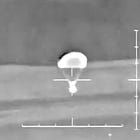Red Sea Updates, US, Jordan Airdrop Humanitarian Assistance Into Gaza
These airdrops are part of a sustained effort to get more aid into Gaza, including by expanding the flow of aid through land corridors and routes.
U.S. Central Command: U.S. Central Command and the Royal Jordanian Air Force conducted a combined humanitarian assistance airdrop into Gaza on March 2, 2024, between 3:00 and 5:00 p.m. (Gaza time) to provide essential relief to civilians affected by the ongoing conflict.

US Carries Out 2 Strikes Against 6 Mobile Anti-Ship Cruise Missiles, Shoots Down Drone Over Red Sea
Video and pictures of the preparation and airdrop of 38,000 meals to the people of Gaza on Mar. 2.
The combined operation included U.S. Air Force and RJAF C-130 aircraft and respective Army Soldiers specialized in aerial delivery of supplies, built bundles and ensured the safe drop of food aid. U.S. C-130s dropped over 38,000 meals along the coastline of Gaza allowing for civilian access to the critical aid.
The DoD humanitarian airdrops contributes to ongoing U.S. government efforts to provide life-saving humanitarian assistance to the people in Gaza. We are conducting planning for potential follow-on airborne aid delivery missions.
These airdrops are part of a sustained effort to get more aid into Gaza, including by expanding the flow of aid through land corridors and routes.
PENTAGON: U.S., Jordanian Forces Deliver Humanitarian Aid to Civilians in Gaza
PENTAGON: The U.S. Defense Department and the Royal Jordanian Air Force conducted a combined humanitarian assistance airdrop into Gaza to deliver critical relief to civilians affected by the ongoing conflict.
As part of the combined operation, U.S. Air Force C-130 Hercules aircraft delivered more than 38,000 meals along the coastline of Gaza allowing civilians access to much-needed assistance.
The U.S. Central Command forces, which also included Army personnel specialized in aerial supply delivery, were joined by Royal Jordanian Air Force C-130s in conducting the operation.
In total, 66 bundles of aid were dropped from three aircraft as part of the combined operation.
In a statement following the operation, Secretary of Defense Lloyd J. Austin III thanked the forces involved for conducting an "important mission, which contributes to the ongoing international and U.S. efforts to provide humanitarian relief for the people of Gaza."
The operation follows President Joe Biden's announcement on Friday that the U.S. would begin delivering aid in response to the increasingly dire humanitarian situation in Gaza amid the ongoing Israel-Hamas war.
"Innocent lives are on the line and children's lives are on the line, and we won't stand by and let — until they — until we get more aid in there," Biden said in remarks ahead of his meeting with Italian Prime Minister Giorgia Meloni at the White House.
The president pledged that the U.S. would "pull out every stop we can to get more assistance in."
Administration officials said today that the combined humanitarian assistance airdrop is part of a broader campaign to ensure civilians in Gaza have access to aid.
"We're looking at the land routes, we're looking at a sea route, we're looking at the air route to really ensure that we're exploring every opportunity to get assistance in," the official said.
Officials stressed that the U.S. has led efforts to push for the free flow of aid into Gaza since the early days of the crisis that was sparked by the deadly Hamas attack on Israel on Oct. 7.
"But the truth is, and you heard the president talk about this yesterday, that the aid flowing into Gaza is nowhere near enough and nowhere near fast enough," the official said.
The official added that the administration continues to work to increase the amount of aid flowing through previously established routes while pursuing new routes to deliver assistance.
Officials said international efforts to distribute aid within Gaza have been stymied by a complex set of factors that have continued to worsen over time. Those factors include the removal of protection for international aid convoys.
Officials also point to increasing lawlessness and the looting and reselling of critical aid by criminal gangs as a major impediment to distributing the aid to those in need.
"There's a way that you resolve this problem," one official said. "And the way is you flood the market. You bring in humanitarian assistance from every point you can – air, sea, land."












